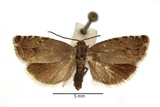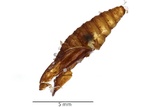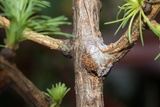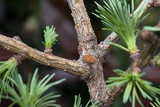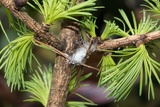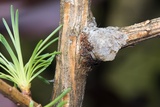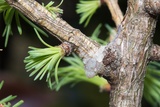Cydia millenniana (Adamczewski, 1967) Species
Last modified: Oct. 31, 2024, 2:50 p.m.
A very rare and local species in Belgium.
Details
- Classification
- Family: Tortricidae > Subfamily: Olethreutinae > Tribus: Grapholitini > Genus: Cydia > Species: Cydia millenniana
- Vernacular names
- Donkergrijze spiegelmot (NL), Breckland Piercer, Larch Gall Moth (EN), Lärchengallen-Wickler (DE)
- Synonyms
- Cydia zebeana sensu auct., nec (Ratzeburg, 1840)
- First mention in Belgium
- De Crombrugghe G. 1903. Note sur quelques Lépidoptères de la faune belge et sur leurs larves. — Revue mensuelle de la Société entomologique namuroise 3: 52–55. On page 54.
- Status
-
Native
Distribution
Imago
Wingspan 14–18 mm. A dark slate greyish moth with silver-tipped scales, often with a steal-blue metallic sheen. Five or more cream or white strigulae present on the costa interspersed with black. Bluish plumbeous striae arise from these costal strigulae, two of which edge the ocellus. Prominent black marks are present in the ocellus and beyond near the outer margin. Also a prominent black mark prior to the ocellus.
Mine
As the galls are always found high in the treetops, it is best to look for fresh-cut trees to find them.
Bionomics
The caterpillars need 2 years to develop. The young larvae live in the first year under the bark and bore tunnels into the bark of young larch twigs. As they develop further in the second year, resinous galls begin to form, sometimes swelling to twice or more the twig’s normal diameter. Each gall remains soft and spongy while it is occupied by a larva, which lives in a densely woven feeding tunnel and pupates
later inside its walls in the spring of the second year. The pupa works its way out of the web tube before hatching.
The adults are rarely observed as they fly most of the time in the higher treetops. They come to light.
Flight periods
The adults can be seen from early May towards late June.
Habitat
It inhabits areas where larch is abundant.
